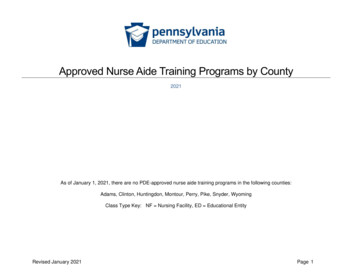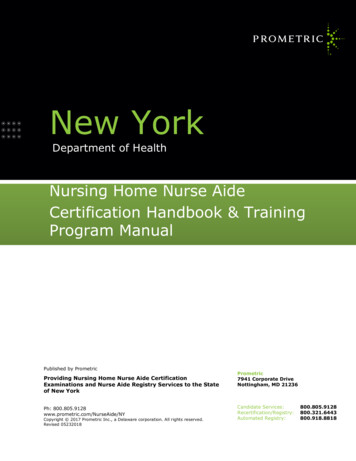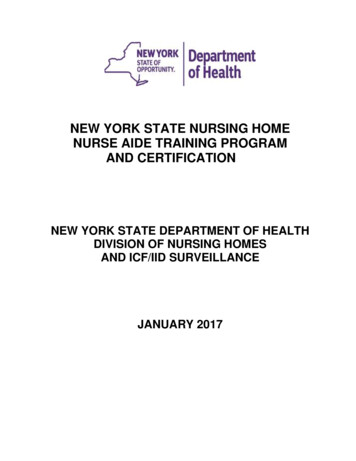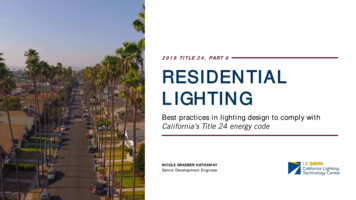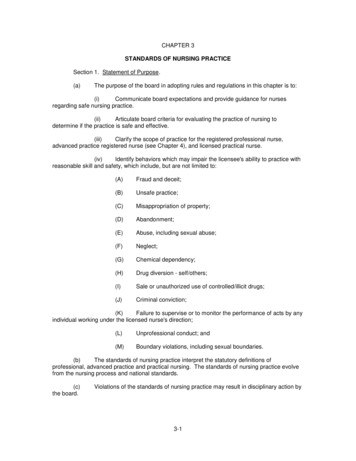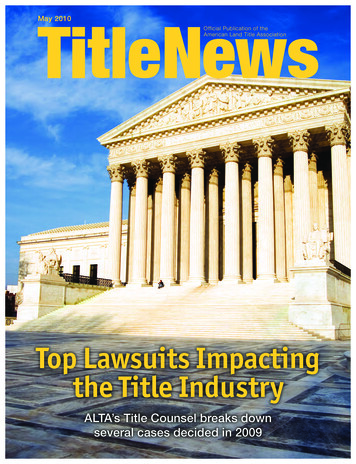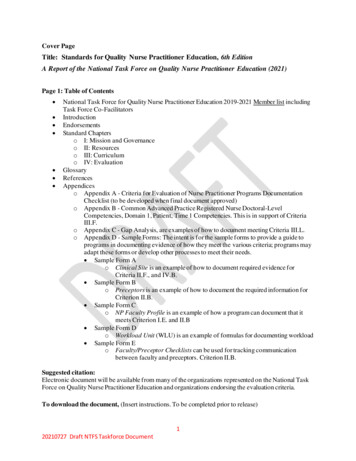
Transcription
Cover PageTitle: Standards for Quality Nurse Practitioner Education, 6th EditionA Report of the National Task Force on Quality Nurse Practitioner Education (2021)Page 1: Table of Contents National Task Force for Quality Nurse Practitioner Education 2019-2021 Member list includingTask Force Co-FacilitatorsIntroductionEndorsementsStandard Chapterso I: Mission and Governanceo II: Resourceso III: Curriculumo IV: EvaluationGlossaryReferencesAppendiceso Appendix A - Criteria for Evaluation of Nurse Practitioner Programs DocumentationChecklist (to be developed when final document approved)o Appendix B - Common Advanced Practice Registered Nurse Doctoral-LevelCompetencies, Domain 1, Patient, Time 1 Competencies. This is in support of CriteriaIII.F.o Appendix C - Gap Analysis, are examples of how to document meeting Criteria III.L.o Appendix D - Sample Forms: The intent is for the sample forms to provide a guide toprograms in documenting evidence of how they meet the various criteria; programs mayadapt these forms or develop other processes to meet their needs. Sample Form Ao Clinical Site is an example of how to document required evidence forCriteria II.F., and IV.B. Sample Form Bo Preceptors is an example of how to document the required information forCriterion II.B. Sample Form Co NP Faculty Profile is an example of how a program can document that itmeets Criterion I.E. and II.B Sample Form Do Workload Unit (WLU) is an example of formulas for documenting workload Sample Form Eo Faculty/Preceptor Checklists can be used for tracking communicationbetween faculty and preceptors. Criterion II.B.Suggested citation:Electronic document will be available from many of the organizations represented on the National TaskForce on Quality Nurse Practitioner Education and organizations endorsing the evaluation criteria.To download the document, (Insert instructions. To be completed prior to release)120210727 Draft NTFS Taskforce Document
National Organization of Nurse Practitioner Faculties1200 18th Street, NW, Ste. 700Washington, DC 20036Nonpf@Nonpf.org and www.nonpf.org .American Association of Colleges of Nursing655 K Street NW, Suite 750Washington, DC 2001www.aacnnursing.orgPage 2: National Task Force Organizational 8.19.Accreditation Commission for Education in NursingAmerican Academy of Nurse Practitioners Certification BoardAmerican Association of Colleges of NursingAmerican Association of Critical-Care Nurse, Certification CorporationAmerican Association of Nurse PractitionersAmerican Nurses Credentialing CenterAmerican Psychiatric Nurses AssociationAssociation of Faculties of Pediatric Nurse PractitionersCommission on Collegiate Nursing EducationGerontological Advanced Practice Nurses AssociationInternational Society of Psychiatric-Mental Health NursesNational Association of Neonatal Nurse PractitionersNational Association of Nurse Practitioners in Women’s HealthNational Association of Pediatric Nurse PractitionersNational Certification CorporationNational Council of State Boards of NursingNational Organization of Nurse Practitioner FacultiesNational League for Nursing Commission for Nursing Education AccreditationPediatric Nursing Certification Board220210727 Draft NTFS Taskforce Document
Standards for Quality Nurse Practitioner Education, 6th EditionA Report of the National Task Force on Quality Nurse Practitioner Education (DRAFT 2021)Preamble:The National Task Force (NTF) for Quality Nurse Practitioner Education, a multi-organizationalcollaboration, has been committed to the maintenance of the high quality of nurse practitioner (NP)education through sustained efforts of periodic review and modifications in standards and criteria.Standards for Quality Nurse Practitioner Education, 6th Edition. The work reflects the currentreview process undertaken by the NTF to ensure that these national consensus-based standards arerelevant to ensuring quality in NP programs.Standards for Quality Nurse Practitioner Education, 6th Edition sets new standards and revisedcriteria to facilitate program improvement through planning, quality assessment, and programimprovement. The document provides a basis for the assessment of a NP program’s fulfillment of nationalprofessional education standards.The National Task Force Standards (NTFS) report focuses on the program level rather than the individualstudent level. Within the four chapters, this NTFS 6 th edition provides a framework for the application ofstandards and criteria. Within each chapter, the standard is clearly defined. The criteria further elaborateon the components and specificity of the standard and requirements needed to meet the standard.Standard One focuses on the institutional support for the NP program with alignment of themission/philosophy/values, faculty involvement in governance, appropriate policies to enhance programquality and improvement, and to advance diversity equity and inclusion. Standard Two focuses on theresources required for a quality program addressing the fiscal, human, student services, learning, andphysical support necessary for quality programing. Standard Three focuses on the curriculum necessary toprepare students for the NP role, mandating the necessity of meeting national standards and outlining thedepth and breadth of requisite knowledge and skills for student success as demonstrated through NPstudent learning experiences, testing, and overall evaluation. Standard Four focuses on the systematicevaluation process for ongoing quality improvement through assessment of program outcomes, resources,curriculum, faculty, and students. These standards and criteria apply to all NP education programs and thedocument remains degree neutral.As of (month tbd) 2021 this edition has been endorsed by the national organizations listed on page XX.Review and Revision Process:The National Organization of Nurse Practitioner Faculties (NONPF) and the American Association ofColleges of Nursing (AACN) reconvened the NTF in December 2019. Nineteen (19) organizations,whose activities are related to NP education, program accreditation certification, licensure, or practice,were represented on the NTF. The NTF members (organizational representatives) met through acombination of face-to-face and virtual meetings, using web-based technology and email communicationsto advance its work. By December 2020, the NTF had completed an initial review and revision of the 6 thEdition of the NTFS. The NTF representatives then shared the draft document with their respectiveorganizational leadership for comment. The NTF addressed organizational comments in further revisionsto the document and incorporated changes before releasing the document for public review and commentsin August 2021. After further revision, the final document was released in (Month tbd) 2021. The NTFremains committed to upholding the timeliness of this document and will continue the cycle of review andrevisions every 3-5 years unless rapid changes in NP education warrant more frequent review.320210727 Draft NTFS Taskforce Document
Major Changes:The APRN Consensus Model (APRN Consensus Work Group & National Council of State Boards ofNursing APRN Advisory Committee, 2008) continues to serve as a foundation for the standards andcriteria. A standard was added to each of four chapters to establish clear expectations for quality. Forease of use, six chapters were reduced to four chapters. This 6 th edition merges existing and new criteriaas appropriate under the applicable standard. The previous editions contained an elaboration section foreach criterion. The elaboration sections were eliminated and required evidence was strengthened toclearly outline expected documentation. Moreover, the glossary definitions and appendices were revisedto reflect the document intent.As part of its initial work, the NTF explored emerging trends in health profession and higher education.One of these trends is the transition to time-variable, competency-based education (CBE). The NTFengaged in robust study and discussion regarding this transition and supports the transition to CBE.However, the consensus was that NP education has not developed CBE and assessment processessufficiently to support the elimination of a minimum number of direct care clinical hours for qualityeducation.The second trend addressed by the NTF was the inclusion of interprofessional education (IPE) in NPeducation programs. The NTF agreed that IPE experiences are essential for preparing NPs for IP practice.The third trend addressed by the NTF was advancement of simulation for health professions education.The NTF agreed that simulation has a role in learning and assessment of NP students. However,additional evaluation of its appropriate, reliable uses for NP learning and assessment is needed. TheNTFS address the use of simulation to support the learning and assessment particularly for thedevelopment of competencies prior to engaging in precepted direct care experiences.Finally, the fourth trend addressed was the need for increased emphasis on diversity, equity, inclusion(DEI) in health professions education. The NTF addresses institution and program policies and practicesrelated to (DEI). In addition, NP programs are strongly encouraged to view its program, policies,curriculum, faculty, and student experiences through a lens of DEI as well as social determinants ofeducation.EndorsementsIn an ongoing effort to strengthen national support for the evaluation criteria, the NTF seeks endorsementof the final evaluation, standards, and criteria from organizations. Endorsement is defined as “a generalphilosophical agreement with the content and intent” of the evaluation criteria. Endorsing organizationsare listed in the front of the document.420210727 Draft NTFS Taskforce Document
I. Mission and GovernanceStandard: The institution’s mission/philosophy/values and governance achieve educational excellence,through a structure that addresses quality assurance, quality improvement, and diversity, equity andinclusion. Effective, ongoing formal processes are in place for self-assessment and planning for thepurpose of program improvement. Through faculty governance, institutional policies commit tosupporting quality within the nurse practitioner (NP) program.Criterion I.A. The mission/philosophy/values of the institution promote academic excellence and supportNP education at the graduate level.Required Evidence: The mission/philosophy/values statements of the governing institution and nursing education unit.The mission/philosophy/values statements of the institution and nursing education unit arereflected across the NP curriculum, delivery modality, and program outcomes.The mission/philosophy/values statements of the institution are accessible to the public.Criterion I.B. The governance structure within the institution facilitates ongoing quality improvementthrough participation of a community of interest, including administrators, faculty, students and practicepartners in the development, implementation, maintenance, and evaluation of the NP program.Required Evidence: NP program defines the community of interest and shows a clear pathway of inclusion andopportunity to provide input regarding the governance of the NP program.Minutes of meetings held with the community of interest.Minutes of meetings documenting development, implementation, maintenance, and evaluation ofthe NP program, which depict how input from community of interest has been utilized.Minutes reflecting ongoing input and documentation of actions based on data collected fromcommunity of interest.Criterion I.C. The NP program maintains accessible, updated written policies and procedures that reflectequitable and non-discriminatory practices.Required Evidence: Transparent processes for review of policies and procedures to ensure policies andimplementation are equitable, and non-discriminatory.Policies and procedures, including date reviewed, that establish:o published materials for student recruitment, including program length, tuition, and fees,o admission, progression, and graduation requirements,o selection of clinical sites and minimum preceptor qualifications,o selection and use of simulation for learning and the alignment with the national bestpractices and/or standards as identified by the NP program, if simulation is used by theNP program,o on-going faculty input into curriculum development and revision,o faculty, preceptor, clinical site, and student evaluation, ando timelines for review of policies, procedures, and handbooks.Relevant handbooks or program materials that inform and supporto Facultyo Student ando Preceptor520210727 Draft NTFS Taskforce Document
Criterion I.D. The institution engages in ongoing, systematic, and focused recruitment and retentionactivities, to achieve mission appropriate diversity among its students, faculty, administrative staff, andother relevant members of the academic and clinical community.Required Evidence: Policy goals and outcomes for achieving mission appropriate diversity, equity, and inclusionProcesses and actions for recruitment and retention of faculty, administrative staff, and studentsRetention plan with measurable diversity, equity, and inclusion outcomes.Policies and actions for recruitment of preceptors and other members of the academic and clinicalcommunity.Criterion I.E. For each NP population-focused track, the institution employs a NP faculty member whoholds an institutional appointment to provide direct oversight, and who is doctorally prepared, currentlylicensed or authorized to practice and nationally board certified as an NP in the population focus,including either primary or acute care.Required Evidence: Dedicated time to provide administrative, resources, curriculum and evaluation oversight for thepopulation focused track.Knowledge of population focused track standards and a faculty position to provide input andmake decisions on curriculum and program outcomes.Curriculum vitae of the NP faculty member who provides oversight for the population-focusedtrack.Current unencumbered licensure or authorization to practice as an NP as required by the state orterritory.Doctoral degree from an institution of higher education that is accredited by an agency officiallyrecognized by the US Secretary of Education at the time the degree was conferred.If not doctorally prepared, documentation of:o Enrollment in a doctoral education program, with anticipated completion date specifiedwithin 5 years of enrollment, ando Letter of appointment prior to date of implementation of these criteria.National board certification(s) as an NP in the population-focused area of the track, specifyingprimary and/or acute care if certified in adult/gerontology or pediatrics.o If the faculty member is not nationally board certified as an NP in the population-focusarea of the NP track, to include primary or acute care distinctions, documentation must beprovided of the qualifications and experiences of the individual overseeing the track tocover the full scope of the population focus or document that the NP faculty members arecertificated and have expertise to cover the full scope of the population focus.o A Clinical Nurse Specialist (CNS) may provide oversight of a Psychiatric Mental Health(PMH) NP program with documentation of degree(s) and national certification(s) as aPMH CNS.Specific position responsibilities of the faculty member who provides direct oversight to the NPpopulation-focused track.Criterion I.F. The institution’s policies and expectations for NP faculty are consistent with other facultyin the institution with the same academic rank and role regarding allocated time for teaching, service,scholarship, and faculty development within the context of the institution’s mission.620210727 Draft NTFS Taskforce Document
Required Evidence: Institutional policies or guidelines clearly articulated for academic rank and role.Institutional policies or guidelines supportive of the faculty workload for successful teaching,scholarship, service, and professional development.Faculty workload formulas delineated for the academic unit to determine assignments.Criterion I.G. The institutional policies support NP faculty teaching in diagnosis and management and/orclinical courses to maintain clinical expertise by engaging in clinical practice.Required Evidence: Institutional guidelines, and/or policies support clinical practice for those teaching in diagnosis,management, and clinical courses.Criterion I.H. The institution has a policy that supports the completion of an NP workforce needsassessment and capacity assessment prior to initiating a new NP program or new population focus.Required Evidence: Policy or statement detailing the process for conducting a needs assessment for new NP programsor a new population focus.Completed needs assessment completed prior to starting a new program or a new populationfocus.Needs assessment with input from community of interest.Capacity assessment to implement new program or population focus based on the NTF Standardsand Criteria.Criterion I.I. The institution has a comprehensive written policy/plan to address anticipated needs forclinical placement sites needed for all matriculated students to meet the learning expectations of theprogram and for their timely progression until completion of the program.Required Evidence: Policy and plan on record for attainment of clinical sites; including identification of individualsresponsible for identifying, evaluating, and contracting.Program policies that delineate processes for selection and evaluation of NP clinical sites.Program policies that delineate processes for NP student clinical placements to provide studentsexperiences to meet role and population-focused learning objectives.Plan delineating faculty responsibilities for clinical placements if not described in the bulletsabove.Plan for identifying new clinical sites if new population foci are developed and/or enrollmentincreases in existing program(s).Criterion I.J. The NP program has policies for recruiting, selecting, orienting, and evaluating preceptorsto enable students to meet learning outcomes and timely program completion.Required Evidence: Program policies that delineate processes for selecting, orienting, and evaluating preceptors.Preceptor orientation materials/program.720210727 Draft NTFS Taskforce Document
Chapter II: ResourcesStandard: Institutional resources are sufficient for the NP program’s matriculated students and reflectongoing commitment to quality education leading to safe and competent graduates. Resources necessaryto sustain the NP program are inclusive of fiscal, human, student support services, learning, and physical.Criterion II.A. The institution has sufficient fiscal resources to support the NP program inclusive ofhuman, student support, physical, and learning requirements.Required Evidence: Budget allocations/expenditures for the NP programProcess for NP program faculty to provide input regarding the budgetary and other resourceneeds.Criterion II.B. The NP program has sufficient human capital, including appropriately qualified faculty,preceptors, and staff, to gain and maintain quality education by supporting achievement of programoutcomes and timely student completion of the NP program.Required Evidence for Faculty: Overall faculty workload and method for determining faculty workload for all clinical and nonclinical learning.Formula used to demonstrate 1 Full Time Equivalent (FTE) NP Program faculty to a range of notto exceed 12 to 24 matriculating NP students. NP Program faculty is defined as all faculty whoteach didactic or clinical courses in the NP program or track. (Formula Example, Sample Form E)The method used to determine NP faculty to student ratios is sufficient to provide adequateclinical oversight, supervision and evaluation of students, preceptors, and the clinical learningexperiences.o NP faculty to student ratio range of not to exceed 1:6 to1:8 ratio for oversight of clinicallearning within faculty workload formula.Description of the specific responsibilities of the faculty members who teach in the NP program.All NP faculty teaching in the NP program have the preparation, credentialing, and currentexpertise to support the NP program curriculum.o Curricula vitae of faculty.o Degree(s), national certification(s), and licenses or authorization to practice as an NP inthe state or territory of practice.o Documentation that all NP faculty who graduated from an NP program after 2015, theimplementation date of the APRN Consensus Model, hold a current license orauthorization to practice as a NP (in the state in which they reside or where the school islocated at a minimum) and national NP certification(s).Documentation of clinical practice for faculty teaching in diagnosis and management or clinicalcourses.All non-NP faculty teaching in the NP program have the preparation, credentialing, and currentexpertise to support the NP program.o Curricula vitae of faculty who teach in the NP program.o Degree(s), authorization to practice by the state, and national certification(s) asapplicable.Development opportunities to support faculty’ in the role such as assessment, evaluation, learningand teaching modalities, and advances in health care.Formal orientation and mentoring of all newly hired NP faculty and those new to teaching.820210727 Draft NTFS Taskforce Document
Required Evidence for Clinical Preceptors: Number and qualifications of preceptors to facilitate students’ clinical learning experiences in thepopulation foci of the program.Formal orientation for new preceptors.Communication between faculty and preceptors regarding course materials and demonstratedunderstanding of the course objectives, estimated clinical hours, evaluation forms andcompetencies the student is expected to achieve.A statement describing the specific responsibilities of the preceptor.Current contractual agreements between institutions/nursing program and preceptors and/orclinical sites where preceptors practice and/or are employed.Preceptor’s preparation and current expertise to support the student’s development of NPprofessional role and student achievement of expected program clinical outcomes.o Relevant biography/curriculum vitae of preceptors that addresses current qualifications.o Documentation of degree(s), unencumbered RN and NP licensure, and nationalcertification(s) of preceptors, as applicable.Required Evidence for Staff: Documentation of sufficient numbers of appropriately prepared staff in the following areas tosupport students and faculty for successful achievement of program outcomes:o Administrativeo Clinical placemento Instructional designo TechnologyCriterion II.C. The NP program has access, to comprehensive institutional student support services thatfacilitate quality education by supporting achievement of program outcomes and timely completion of theNP program, regardless of delivery modality.Required Evidence: Services available to NP students including but not limited to:o Financial aido Counselingo Writing instruction and supporto Health and wellnesso Academic advisementCriterion II.D. The NP program has sufficient learning resources to facilitate quality educational andclinical experiences for NP students to achieve program outcomes, attain national NP competencies forthe role and population, and ensure timely completion of the NP program regardless of delivery modality.Required Evidence: Access to sufficient library and/or resources to support students and faculty to achieve theprogram outcomes.Simulation resources and services are used in alignment with national best practices and/orstandards as identified by the NP program and to include:o Preparation of faculty/staff to facilitate simulation, ando Physical and fiscal resources to support the use of simulation such as standardizedpatients, technology, equipment.920210727 Draft NTFS Taskforce Document
Documentation of learning resource technology and support for its use, including electronicclinical logs/encounters and e-portfolios.Criterion II. E. The NP program has access to sufficient institutional physical resources that supportquality educational experiences for NP students to achieve program outcomes and timely completion ofthe NP program regardless of delivery modality.Required Evidence: Facilities, equipment and supplies available and accessible to faculty, students, and staff tosupport quality education experiences.Facilities, equipment and supplies available and accessible to faculty, students, and staffregardless of program delivery modality.Criterion II.F.: The program has clinical sites and preceptors to ensure students enrolled in clinicalcourses have experiences to meet learning objectives and demonstrate expected course competencies withtimely completion of the NP program. The NP students’ clinical placements are aligned with the programrole and population focus. Faculty are the decision makers for determining appropriate clinicalplacements.Required Evidence: Sufficient number of appropriate clinical placement sites to support enrolled students’ directcare clinical experiences and learning outcomes for the population foci and timelycompletion of the NP program.The faculty role in ensuring clinical placement of students and oversight to ensureappropriateness of clinical sites, preceptors, and experiences.The faculty communications/meetings with preceptor(s) regarding the expectations for thestudent experience and assessing student progression.III CurriculumStandard: The nurse practitioner (NP) program curriculum is designed, reviewed, revised, and evaluatedby the NP faculty to maintain currency and meet national standards. The curriculum addressescompetencies as delineated by specialty nursing organizations, NP organizations and nursing educationorganizations and promotes student achievement of learning and program outcomes. The curriculumestablishes the depth and breadth of requisite knowledge and skills for student success in the NP programas demonstrated through NP student learning experiences, testing, and overall evaluation.Criterion III.A. The NP faculty have input into specific admission criteria for each NP populationfocused track and degree/certificate program.Required Evidence: Documentation demonstrating that NP faculty are providing input to admission criteria specific tothe NP program and/or tracks.1020210727 Draft NTFS Taskforce Document
Admission criteria for the NP program and/or individual population focused tracks differing fromthe overall school of nursing graduate degree program are clearly defined, explained, andaccessible to the public.Criterion III.B. The NP faculty provide input for any progression and completion criteria specific to theNP population focused track.Required Evidence: Documents affirming that NP faculty provide input into progression and completion criteriaspecific to the NP program and/or tracks.Student progression and completion criteria including the overall graduate degree program andprogrammatic differences unique to the NP Program or the population focused tracks.Criteria for full-time, part-time, and postgraduate study as pertinent.Faculty designed plans for students to address content mastery deficiencies which adverselyaffect student progression.Criterion III.C. NP faculty provide input to the development, implementation, evaluation, and revisionof the entire curriculum, including the graduate nursing core courses, APRN core courses, and NPpopulation-focused courses.Required Evidence: Formal committee minutes documenting that NP faculty are developing, evaluating, and revisingthe curriculum.Resources used, including professional standards, competencies, and guidelines.Criterion III.D. The NP curriculum provides the student broad-based, comprehensive graduateeducational preparation in the role and at least one population focus area of study. The curriculum isconsistent with and meets national standards/competencies for graduate-level nursing education, APRNeducation, NP specific role, and population focused education.Required Evidence: Description of NP curriculum that provides the student broad educational preparation and followscurrent nationally recognized standards and competencies for advanced level nursing education,NP role preparation and population focus preparation.The national recognized NP education standards and competency documents used for thedevelopment of the curriculum components including,o Advanced-level nursing education competencies,o APRN graduate core courses in advanced health assessment, advancedphysiology/pathophysiology, and advanced pharmacology,o NP core competencies for the role, ando NP population-focused competencies.Criterion III.E. The NP curriculum includes interprofessional educational experiences (IPE).Required Evidence:1120210727 Draft NTFS Taskforce Document
Curriculum plan that demonstrates how the program prepares graduates with nationallyrecognized interprofessional education competencies.Curriculum plan with NP students didactic and clinical experiences with other health professionalstudents.Student logs, reflections, and evaluation of learning experiences that demonstrate integration ofinterprofessional experiences and/or documentation of IP scholarly work.Criterion III.F. The NP program identifies specific patient care competencies that each student mustattain and demonstrate, through simulation/labs or other faculty facilitated learning experiences, prior tobeginning precepted clinical experiences that focus on diagnosis and management of health problems.Required Evidence: Competencies required for the student prior to precepted clinical experiences, as outlined inDomain 1, Time 1 Patient Care of the Common Advanced Practice Regist
Jul 27, 2021 · 7. American Psychiatric Nurses Association 8. Association of Faculties of Pediatric Nurse Practitioners 9. Commission on Collegiate Nursing Education 10. Gerontological Advanced Practice Nurses Association 11. International Society of Psychiatric-Mental Health Nurses 12.



